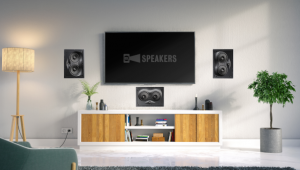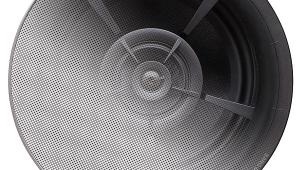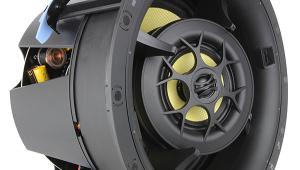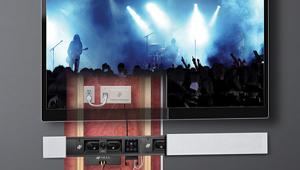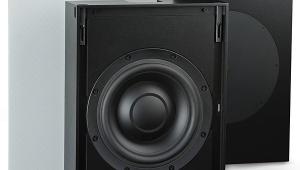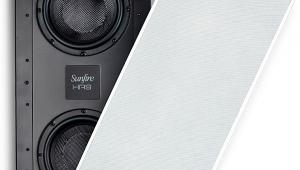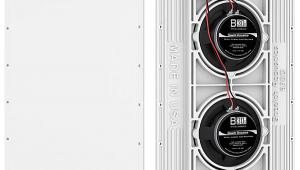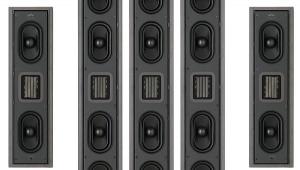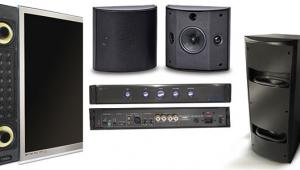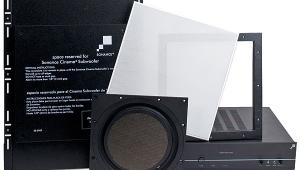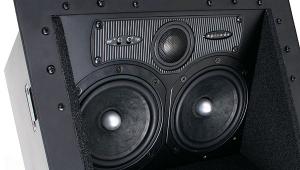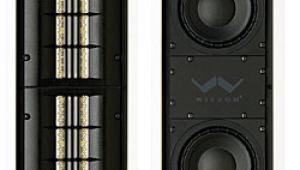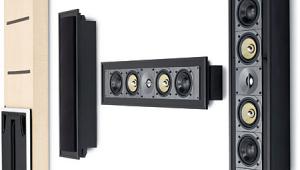Listened to it on Tidal while I read the article. Wow.
GoldenEar Technology Invisa Signature Point Source In-Wall Speaker System Review
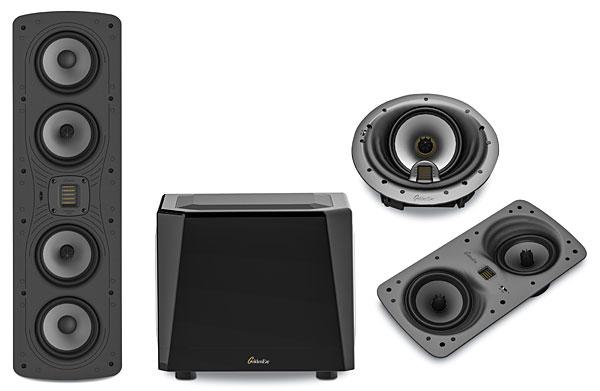
AT A GLANCE
Plus
Rotatable pleated tweeter for horizontal orientation
2½-way design
High performance-to-cost ratio
Minus
Horizontal installation requires modification of wall stud
THE VERDICT
With the Invisa Signature Point Source in-wall speakers, GoldenEar Technology has introduced an in-wall speaker with a performance-to-price ratio that rivals in-room competitors.
Just as not everyone prefers to eat turkey on Thanksgiving, there are some people who don’t like to have tower speakers standing at attention (and drawing attention) in their family’s living room. At our family’s traditional Thanksgiving chow-down (at Christmas, we have a ho-ho-hoedown), we serve baked ham as an alternative to the delicious, funny-looking bird the rest of us enjoy. (Those who don’t like either choice get bread and water.) For people who can’t or won’t have tall, floorstanding speakers in the vicinity of their TV, the acoustic equivalent of baked ham is a set of in-wall speakers. (Those who don’t like in-room or in-wall speakers get their own kind of bread and water: a cheap soundbar with no subwoofer. Only those on the naughty list must endure the speakers built into the TV.)
Although the thought that a pair of in-wall speakers could ever approach the sound quality of a really good set of in-room speakers is laughable for many people who are serious about listening to music and movies, there are a handful of speaker designers who honestly think it’s possible to engineer such a thing. In other words, these acoustic chefs believe that, with the right combination of spices, they can make ham taste—um, sound—like turkey. (But not sound like a turkey, because that would be totally plucked up.)
References, Please
Sandy Gross of GoldenEar Technology is one of those pumpkin-pie-in-the-sky dreamers who say, “I want to have my ham and eat my turkey, too.” Having helped co-found not only GoldenEar but also two other speaker companies, Polk Audio and Definitive Technology, Gross is no stranger to the design pitfalls of trying to shove a speaker in a wall and make it sound like it’s out in the room. He also has a reputation for coming up with in-room speakers that sound like, well, they’re not in the room: Most recently, Gross (with his engineering partner, Don Givogue, and the design team at GoldenEar’s facility in Ottawa, Canada) introduced the company’s top-of-theline ($4,250/each) Triton Reference powered towers, the ones that turned Al Griffin into an “audio crack”–addicted “music junkie” when he reviewed them for our June 2017 issue. (Word is he still hasn’t left his listening room.)
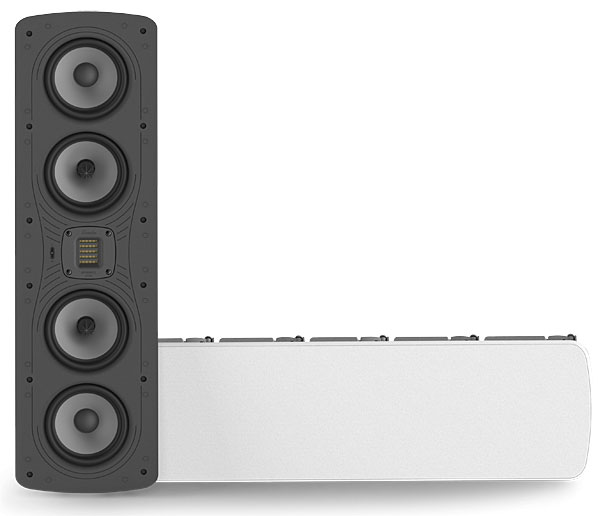
Near the end of his review, Al asked of GoldenEar, “What to do next after creating a speaker called the Reference?” Gross’s answer is the new Invisa Signature Point Source in-wall LCR speaker. At a “mere” $1,000 each, it seems like a flea-market bargain compared with the hefty price of the Triton Reference tower—and, in a way, following up such a fantastic speaker with an in-wall model feels like a letdown. Architectural speakers are a different breed, though, and one thousand bucks for a single in-wall is definitely getting into eyebrow-raising territory. In fact, you have to do some serious searching to find an in-wall or in-ceiling speaker that costs $1K or more. They’re out there—I’ve reviewed a few of them—but there aren’t many. So, for the moment, the Invisa Signature Point Source in-wall is GoldenEar’s first attempt at creating a “reference” architectural speaker.
Turning Towers into Walls
Gross told me that the impetus behind developing the Invisa SPS was the number of customers who requested an architectural speaker with performance similar to that of the Triton series towers. Not surprisingly, the design goal was to “take as much of the technology in the Tritons as possible and put it into an in-wall speaker.”
The result is a 2½-way speaker that borrows heavily from the engineering found in the GoldenEar towers, including four 5.25-inch cast-basket bass drivers—two of these handling midrange duties and employing the company’s multi-vaned phase plugs, and all four incorporating GoldenEar’s Focused Field magnet structure. The single folded planar magnetic tweeter— a standard component of every GoldenEar speaker—is largely based on the tweeter used in the Triton Reference tower. Next to the tweeter is a three-position high-frequency adjustment switch. Gross believes that perhaps the most important element of a speaker is the crossover; he refers to it as the “conductor” that directs the performance of the “orchestra” of drivers. GoldenEar spent a significant amount of development time solely on voicing the speaker.
The SPS measures 28.5 x 8.5 inches, and at about 3.75 inches deep; it fits into standard 2 x 4 stud-constructed walls. Embedded around the outer perimeter of the speaker’s front baffle are 24 small neodymium magnets that tightly hold the off-white metal grille (with a nearly invisible flange design) to the front. Four small pads strategically located inside the grille serve to further minimize extraneous vibrations. The extremely rigid, all-in-one baffle-and-mount assembly includes a double-channel support molded into the back. It has an unusually high number (12) of dog-leg-style clamps around the edges that, combined with the rigidity of the baffle, make the wall feel like it’s made out of brick rather than wallboard once everything is installed.

GoldenEar ships each SPS configured for a straightforward, vertically oriented installation. For horizontal use, the tweeter has four very short screws that are easy to remove (and reinstall), allowing the tweeter to be rotated 90 degrees—which was how I installed the center-channel speaker in the system. If you’re doing a retrofit installation, one of the major drawbacks of any horizontally oriented in-wall center speaker measuring more than 15 inches wide is that one (or possibly more) of the studs in the wall will need to be modified in order to make room for the drivers’ baskets and magnet assemblies. Most pro integrators are prepared to handle it, though. With new construction, the walls can be framed to accommodate the speaker’s dimensions ahead of time.
Newton’s Favorite Technology
The system that GoldenEar put together for me to install and listen to included three Signature Point Source speakers (two vertically for left and right, one horizontally for the center) and two other models from the Invisa series: a pair of MPX Multipolar inwall speakers ($500 each), for the surrounds, and four HTR 7000 in-ceiling speakers ($500 each), for the front and rear Dolby Atmos height channels. From the SuperSub series came one of the company’s fairly recent small-form-factor freestanding subwoofers, the SuperSub X ($1,250). I’ve reviewed the MPX and HTR 7000 speakers as part of previous systems, so I won’t spend much time on them here, other than to say that they include driver and crossover technologies similar in concept and engineering to that of the SPS speakers—especially when it comes to the tweeter in each one.
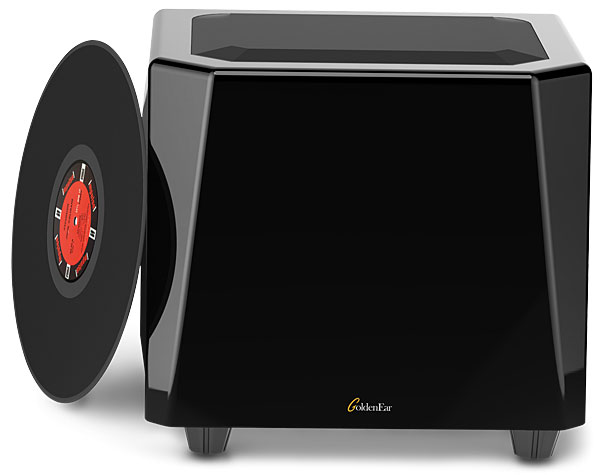
The SuperSub X, measuring 14 inches wide x 12.75 high x 13.25 deep, is a powered subwoofer that uses GoldenEar’s patented Dual-Plane Inertially Balanced Technology. Basically, this is a configuration that pits two active and two passive drivers against each other in an attempt to cancel forces that would shake the cabinet instead of radiating all of the energy into the room—making the cabinet perform more as if it were inert. The SuperSub X is powered by a 1,400-watt-peak Class D amplifier. (The Reference towers include an 1,800-watt amp.)
Double Entendre
I’d heard the SPS in-walls set up as part of a 7.2.4 Atmos system in GoldenEar’s CEDIA booth in September 2017, so I had a pretty good idea that they’d perform quite well in a twochannel system. (As a brief aside, I think a Dolby’s Atmos rig using Dolby Surround upmixing is fantastic with most two-channel source material. In my case, I normally listen to music with my system’s full Atmos array because I like the processing’s delicate handling and expansion of ambience cues in two-channel material. Mainly because of the Invisa series speakers’ similar voicing, the 5.1.4 configuration for this review sounded spectacular with nearly every music selection. But I digress.) If the Invisa SPS speakers were to truly live up to their Triton Reference pedigree, though, they were going to have to be damn good for listening to music—without any caveats related to theatrical performance.
- Log in or register to post comments


